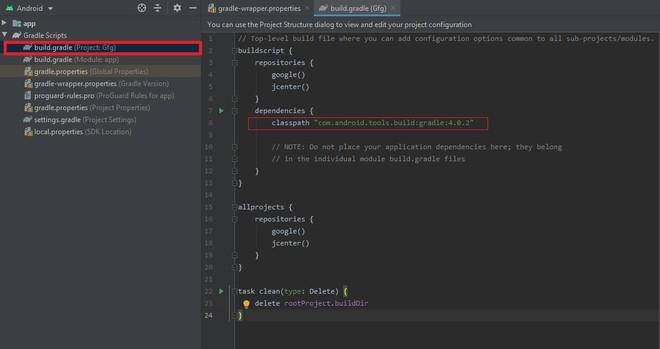

Use this list to configure a Gradle version for your project. Use Gradle as a default option or select IntelliJ IDEA.

Use this list to select how you want to run tests in your project. Yet, keep in mind that the IntelliJ IDEA compiler does not support some parts of the Gradle project build processing and might cause problems in building your project correctly. IntelliJ IDEA supports the incremental build which significantly speeds up the building process. If you have a pure Java or a Kotlin project, it is sometimes better to select IntelliJ IDEA for building a project. In this case when you select Build | Build Project from the main menu, IntelliJ IDEA goes through source sets in all modules executing the Gradle task classes. Use this list to select how you want to build and run your project. Use this section to specify what IntelliJ IDEA should use when you run tests, build, or run tasks in the selected linked project. When this checkbox is selected, IntelliJ IDEA downloads a file with a set of external annotations from the JetBrains public repository. You can configure settings for each selected project.ĭownload external annotations for dependencies You can have several linked Gradle projects when you work in IntelliJ IDEA. iml files get changed as well so don't forget to push them along with the other project's changes under VCS. When you make changes in your Gradle project, the. iml files first and then starts the importing process. You can also opt for the gradle-idea-ext plugin that helps you describe the project settings in the adle file.Ĭorrectly opening a project that contains both regular IntelliJ IDEA modules and Gradle modules.Īccessing a project faster when you open it since IntelliJ IDEA reads the. idea directory stores project-level settings. Sharing the IDE-specific module settings via VCS since the. It might be helpful in the following cases: Select this option to store the generated. Generate *.iml files for modules imported from Gradle IntelliJ IDEA also supports the custom Gradle location installed from the Homebrew package manager. If the Gradle location is set in Use Gradle from with the Specified location option and its path is defined in the environment variable GRADLE_HOME or PATH, IntelliJ IDEA deduces this location and suggests its path as the default value. Manually entered values take precedence over the environment variables. You can specify the location manually: type the location in the path or click and in the dialog that opens, select the needed directory.

You might need to restart your IDE in order for this change to take effect. The variable's value is picked up automatically. For more information, refer to Gradle documentation. You can set the GRADLE_USER_HOME environment variable (for example, %APPDATA%\.gradle). It can be overridden in one of the following ways: The default is set to $USER_HOME/.gradle. Use this field to specify the location for Gradle to store its global configuration properties, initialization scripts, caches, log files, and so on.


 0 kommentar(er)
0 kommentar(er)
